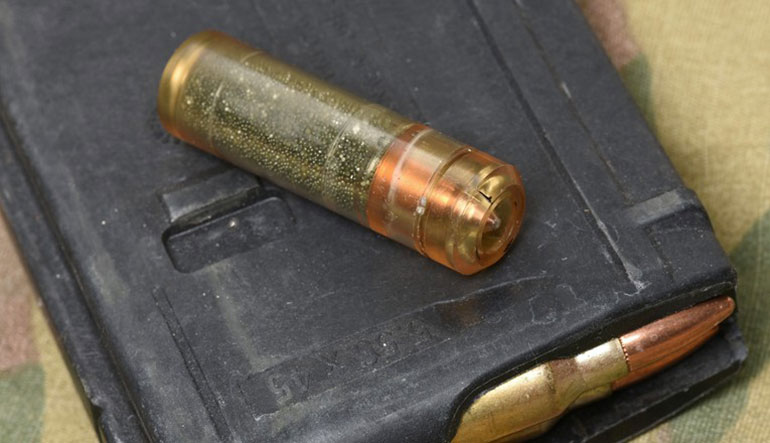The SC
ELITE MEMBER

- Joined
- Feb 13, 2012
- Messages
- 32,233
- Reaction score
- 21
- Country
- Location
Telescoped Ammunition Might Be The Future Of Cartridges

The polymer cartridge case consists of two parts: the body and the end cap. During loading the body is charged with propellant. The end cap, which has the projectile attached directly to it, then seals off the front of the case. The end cap is a robust piece with the projectile held by a slightly undersize sleeve.
Upon firing, the bullet rides through this sleeve, which guides it into the throat of the barrel. This prevents the bullet from becoming slightly off-axis to the rifling, such as can happen with a conventional metallic cartridge damaged during the feed cycle. It is believed this aids accuracy compared to conventional ammunition.
The most obvious advantage of this design is it dispenses with the need for brass or steel cartridge cases, which reduces the manufacturing costs. It also noticeably reduces the weight of the ammunition. It is claimed to be about a 40 percent reduction, which is significant. This allows a soldier to carry more ammunition without carrying more weight.
Overall cartridge length is also reduced with this ammunition, and that in turn can mean a shorter receiver—resulting in a shorter, lighter firearm. Cased telescoped ammunition also requires a simpler operating system, which also leads to a reduction in both weight and complexity—the latter bringing the potential of increased reliability. For one thing, the system eliminates rim problems during the extraction cycle encountered with metallic cartridges.
Plus, because the projectile is seated inside the polymer case, the chance of damaging or setting back the projectile during the feeding cycle is eliminated. And unlike a conventional design, weapon systems utilizing cased telescoped ammunition feed and extract/eject in the same direction. The chamber is actually separate from the barrel, and the new cartridge simply pushes out the spent case during the feeding cycle.
Due to this, there are no timing issues or malfunctions as encountered with a conventional operating system. Instead, everything moves in the same direction. A side benefit to this is the chamber, since it's not attached to the barrel, never gets hot enough to cause a cook off.
In 2011, BAE Systems produced more than 100,000 rounds of the new 40 mm Cased Telescoped Ammunition at its dedicated British facility in Radway Green, Cheshire, where it established strong engineering and production expertise, amounting to four Twice as powerful as 30mm round ammunition,
Cased Telescoped ammunition shows a complete change in power over previous generation medium caliber weapons.
The new munitions, manufactured by BAE Systems for the British Army, contain both the projectile charge and the propellant charge within a single case tube and are very different from conventional munitions and this allows for a greater effect for the same caliber of ammunition.
Defense companies “Nexter” and BAE Systems currently produce a variety of telescopic munitions, including:
- Armor-piercing rounds Piercing Arrow APFSDS-T It is capable of penetrating more than 140 mm of Rolled Homogeneous Armor (RHA) at a distance of 1,500 meters These sub-caliber arrows can defeat all lightly armored vehicles and infantry fighting vehicles, including those heavily protected by additional armor It has a speed of 1500 m / s and a penetration rate of 140 mm at a distance of 1500 meters.
- Anti-drone missiles, helicopters and light aircraft A3B-T With an increased operational range, very high accuracy, and a payload of up to 200 tungsten grains, the air-to-air blast anti-aircraft missile provides the Cased Telescoped Armament System with a highly effective capability, which reduces the number of projectiles needed to destroy the target. The Anti Aerial Airburst missile is particularly effective against unmanned aerial vehicles, unmanned aircraft systems, helicopters and low-speed aircraft at a speed of 900 m/s and a range of 4000 m.
- Interlaced Programmable High Explosive (HE) munitions GPR-AB-T General Purpose Multiple Targets It is a programmable High Explosive (HE) munition that fires an “air” blast at targets up to a maximum range of 2,500 meters The unique projectile is optimized to fragment over the target, This leads to covering a large area on the ground or behind protective barriers and enemy defenses. It also provides the ability to neutralize the vehicle's optical systems, with a speed of 1,000 m / s and effectively covers an area of 125 m 2.
- The GPR-PD-T is a high-explosive munition capable of penetrating more than 210 mm of double reinforced concrete. The unique fragmentation ballistic is improved and the munition provides effective suppression of threats to urban structures and light armored vehicles. It has a speed of 1,000 m / s with a penetration capacity of 210 mm for concrete with a span of 2500 m.
After the success of the field tests of the overlapping ammunition, the US Army is striving to adopt the Next-Generation Squad Weapon project, which adopts the overlapping rounds as a receiver for the LSAT light machine gun ammunition.
With the entry of telescopic ammunition into active service, we should know that its development work has been going on for 11 years, and the French, British and Belgian armies are effectively using 40 mm telescopic ammunition in their armored vehicles.
Source: different sources
Last edited:
